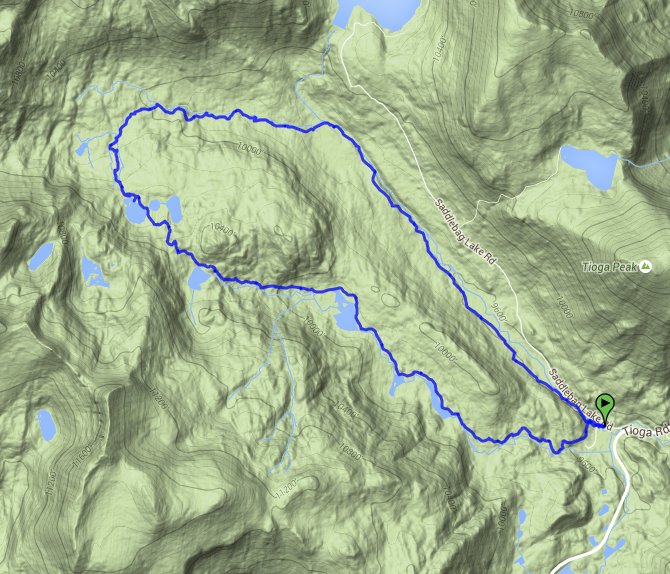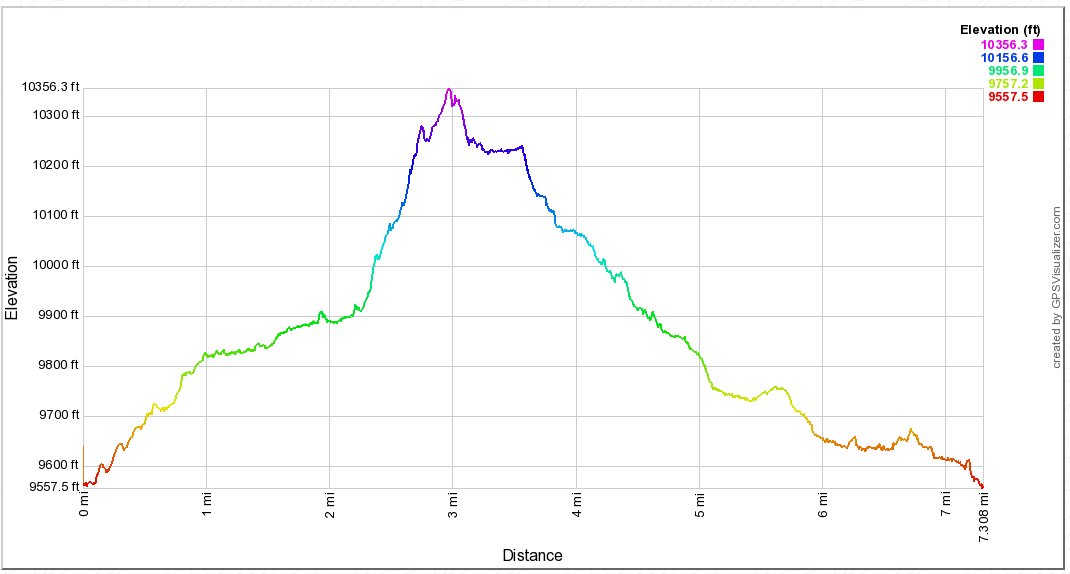
Distance: 8.0 Miles
Vertical Gain: 850'
Group Size: 1
Hike Rating: Easy Moderate Hard Strenuous

 GPX for
this trip
GPX for
this trip

| Start Coordinates: | N 37 56.312, W 119 15.024 | End Coordinates: | Same as Start Coordinates |
||
| Car Shuttle Req'd: | No | Parking Directions: | From Highway 395 turn west toward the Yosemite park entrance on the eastern side of the park. Follow Highway 120 (Tioga Pass Road) approximately 8 miles and turn right on Saddlebag Lake Road. Take an almost immediate left at the fork toward Junction Campground, and park at the coordinates provided near a small plaque giving the history of the town of Bennettville. If these spaces are full, turn around and park along the road between here and Highway 120. | ||
| Hazards of Note: | Some elevation gain, mosquitos, cross-country navigation and use trail route finding. | Crowd Factor: | Minimal. This is a lightly used trail to Bennettville, and even lighter for people using the use trail into the lakes area of the Hall Research Area a few miles north. | ||
| General Notes: Head across the small bridge from the parking area toward Junction Campground, and then turn right at the kiosk and the sign with the slightly misspelled name of the ghost town (missing a "T".) You will head along the creek for a few hundred feet, and then the trail to Bennettville actually makes a sharp left and heads upwards a little bit as opposed to the use trail which continues along the creek. There is a sign here, but be careful not to miss it. The trail which heads north at this point on the side of Lee Vining Creek is actually the one you will be on heading back at the end of the loop. The trail will continue to meander a little bit above the Junction Campground sites, and then head further up along another river with a number of small cascades visible along the way. After a mile you will see the two remaining (restored) buildings from the Bennettville town, the Assayers office and a Barn. There is a small plaque below the barn as you make your way up, and there is information posted on the buildings about the history of each of them. Head west from the buildings, finding and then following a well-defined use trail which heads north to the various lakes in this valley. The first one, Shell Lake, you will reach within a mile, and the trail follows very closely at times, the eastern edge of this clear, alpine lake. Continue past this first lake, past a second, unnamed lake, and within half a mile you will reach Fantail Lake. This is a larger lake than the first, and one group I passed on my way was heading here to fish and then turn back around afterward. Past this lake the trail becomes a little less defined, and sometimes it can be lost in the rocks ahead of you. Just keep heading upward on the north side of this lake toward the northwest, and soon you will reach the third named lake on the way, Spuller Lake. This is where most people stop, as the trail ends here and the next set of lakes are up and over a ridge directly to the north. Continue over this ridge, and soon you will be presented with three lakes. They were actually called, (right to left) Maul, Green, and Treble lakes at first, but a map labelling error caused Green and Treble to be added together to make the left one Green Treble Lake and the middle one now unnamed. Pick your way down large rocks and boulders to aim between the two lakes to the left, and pause to enjoy the pleasant green islands scattered throughout Green Treble Lake. From this point on you will not be on any trail until the very last 1/2 of the trip. You will follow the outlet from Green Treble lake down into an open meadow, crossing numerous waterways as you head north to meet up with Mine Creek. I was unable to find a decent crossing over this waterway, which while frustrating and worrying at first ended up being the best part of the hike. Turn to your right (east) and following along to the south of the creek for over a mile, having to distance yourself at some points to avoid the steep drops that the water makes from time to time. Eventually the creek will merge with Lee Vining Creek ahead, at which point you turn south and stay on the west side of this creek for the rest of the way. The open meadow that Lee Vining Creek cuts through the eastern edge of is beautiful, and offers amazing vistas of Mt. Dana to the south. The pictures on this section were breathtaking, with the color and the beauty all around. Near the last 1/2 mile of the meadow you will find the use trail, which will take you back to the Bennettville trail head and the parking area at Junction Campground. |
|||||
